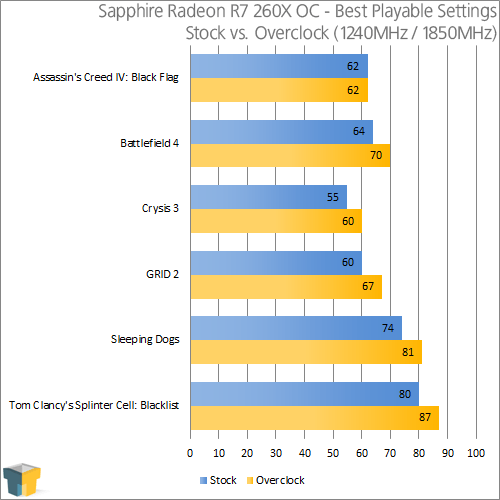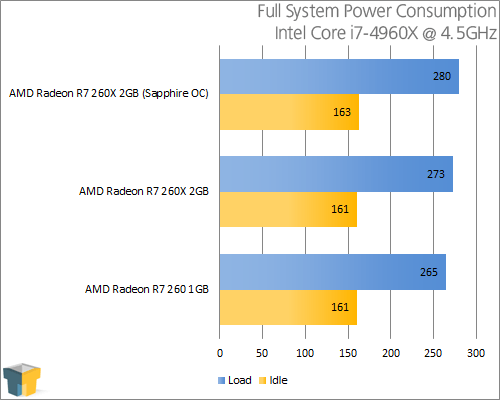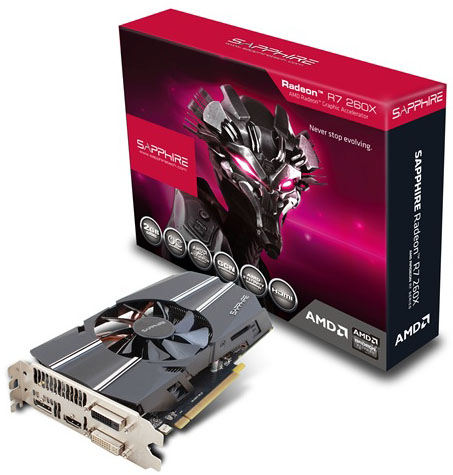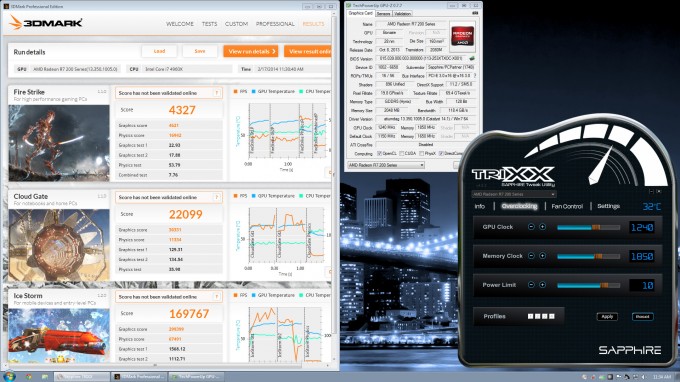- Qualcomm Launches Snapdragon 4 Gen 2 Mobile Platform
- AMD Launches Ryzen PRO 7000 Series Mobile & Desktop Platform
- Intel Launches Sleek Single-Slot Arc Pro A60 Workstation Graphics Card
- NVIDIA Announces Latest Ada Lovelace Additions: GeForce RTX 4060 Ti & RTX 4060
- Maxon Redshift With AMD Radeon GPU Rendering Support Now Available
Sapphire Radeon R7 260X OC 2GB Graphics Card Review

Both AMD and NVIDIA are in the midst of launching new budget GPUs, but neither of them affect the position of the Radeon R7 260X – a great thing as I have Sapphire’s take on the model to tackle. With a boost of 50MHz to the core clock, and an improved cooler, should Sapphire’s R7 260X OC be on your sub-$150 shortlist?
Page 9 – Overclocking & Power, Final Thoughts
I don’t often delve into overclocking with the graphics cards I take a look at, but given the minor differences in performance and featureset between Sapphire’s card here and the reference, I felt some other angle should be tackled. And it should come as no surprise that AMD’s current line-up behaves quite well where pushing the clocks is concerned.
The default clocks of the R7 260X are 1100MHz on the GPU, and 6500MHz on the memory. Sapphire boosts the GPU to 1150MHz, and the memory to 6600MHz. After some minor prodding with Sapphire’s own Trixx tool, I found that 1240MHz on the GPU and 7400MHz on the memory were stable enough to consider it usable (that’s based on a one-hour Unigine Heaven stress).
That said, 1240MHz / 7400MHz is a rather lofty overclock, and there’s absolutely no guarantee that every R7 260X is capable of reaching such lofty heights. However, it could also be that you could go even higher than I did. I didn’t mess with the memory too much after hitting 1850MHz, because the hassle would have been too great for such little gain. I tried 1250MHz GPU but it failed a 3DMark run.
To give these overclocked settings a quick test, I reran all of the “Best Playable” settings using them, and imported the results from the default clocks to produce this graph below:

Note: AC IV: Black Flag caps the FPS at ~62, hence the identical result. I ran it to make sure the overclock didn’t adversely affect the performance of the game.
It’s clear that while a 50MHz boost to the GPU clock can make almost no difference at all, going another 90MHz can. Still, I’m of the mindset that if you want extra GPU performance and can afford it, you should save the stress on your hardware and just go with a bigger model. But, if cash-strapped, no one could blame you for ekeing out every last bit of performance. With this overclock, we’ve no doubt come close to R7 265 performance.
Power & Temperatures
To test graphics cards for both their power consumption and temperature at load, we utilize a couple of different tools. On the hardware side, we use a trusty Kill-a-Watt power monitor which our GPU test machine plugs into directly. For software, we use Futuremark’s 3DMark to stress-test the card, and AIDA64 to monitor and record the temperatures.
To test, the general area around the chassis is checked with a temperature gun, with the average temperature recorded. Once that’s established, the PC is turned on and left to site idle for ten minutes. At this point, AIDA64 is opened along with 3DMark. We then kick-off a full suite run, and pay attention to the Kill-a-Watt when the test reaches its most intensive interval (GT 1) to get the load wattage.


For the moment, consider these power ratings a bit unfinished, as I need to retest due to the realization that some of the variances have been a bit higher than I expected (which means I need to test for power twice or thrice over, not just once as I normally do). That said, on the temperature front the result is very impressive on Sapphire’s side – a staggering 16ºC drop at full load.
Final Thoughts
With the release of AMD’s Radeon R7 250X last week, the R7 260X finds itself in a bit of an odd position. Performance differences have little to do with anything here; instead, it’s all about pricing. Prior to the R7 250X’s announcement, the R7 260X cards were sitting at a comfortable $140 – a number AMD stated should fall to $120. That hasn’t quite happened, although this particular card at one etailer is going for $130 as of the time of writing. As unfortunate as it is, AMD can’t do too much to make sure its SRPs are enforced. Sometimes supply and demand works out to the favor of consumers, and sometimes it doesn’t. It especially doesn’t right now if you want an AMD card and are not a coin miner.
But I digress. If we’re looking at this current sub-$150 lineup from their SRP perspectives, AMD has quite a good thing going. As mentioned before, the R7 250X, R7 260, and R260X are each seperated by $10, and each adds 128 cores over the last. The 260X has the nice benefit though of having a beefier framebuffer (2GB), and faster memory.

When I tested the R7 260 in December, I couldn’t believe what kind of performance (and quality) I was seeing out of a modestly-priced card. Now, given that the R7 260X is faster, I am sure it will come as no surprise that I’m just as impressed. The performance differences between the 260 and 260X are not huge, but I feel it’s well-worth the $10 difference, especially if it happens to be Sapphire’s card here we’re talking about. 16°C off of load? Yes, please.
I’ll soon be checking out both AMD’s R7 265 and also NVIDIA’s GeForce GTX 750 Ti, but neither of those cards will affect the outcome of this one. If you’re in the market for a sub-$150 GPU, Sapphire’s offering here is a good one. You shouldn’t expect to get mind-blowing performance out of it, but the price-point guaranteed that, I’m sure. Even so, what the card does deliver at 1080p is quite good.
Support our efforts! With ad revenue at an all-time low for written websites, we're relying more than ever on reader support to help us continue putting so much effort into this type of content. You can support us by becoming a Patron, or by using our Amazon shopping affiliate links listed through our articles. Thanks for your support!






